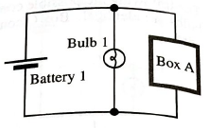
In the circuit at right, the voltage across bulb 1 and the voltage across box A are equal. What, if anything, can you say about the resistance of box A compared to the resistance of bulb 1? Explain.

Write an expression for the voltage across the battery
Learn your wayIncludes step-by-step video

Chapter 20 Solutions
Tutorials in Introductory Physics
Additional Science Textbook Solutions
College Physics (10th Edition)
University Physics (14th Edition)
Essential University Physics: Volume 1 (3rd Edition)
An Introduction to Thermal Physics
College Physics
Essential University Physics (3rd Edition)
- Consider the circuit shown in the figure below. The four capacitors have capacitances C1=15μF, C2=16μF, C3=19μF, C4=13μF and are connected to a battery of voltage V=39Volts. When all capacitors are fully charged, determine the voltage across C4. Express your answer in units of Volts using one decimal place.arrow_forwardConsider the circuit in (Figure 1). Suppose that v₁ = 14 V, v2 = 5 V, and i = 5 mA. Figure i + 1 of 1 5 mA source is absorbing power. 5 V and 14 V sources are developing power. 5 V and 14 V sources are absorbing power. 5 mA source is developing power. All sources are absorbing power. O All sources are developing power. Submit Correct Part G Previous Answers What is the total power developed in the circuit if the polarity of the 14 V source is reversed? Express your answer to three significant figures and include the appropriate units. P= 25 Submit mW Previous Answers Request Answer ? X Incorrect; Try Again; 3 attempts remainingarrow_forwardIn the circuit below, if the battery in the circuit below is 3V, resistor R1=2772, and resistor R2=4122, what is the total or net current in the circuit units of mA? High potential I R1 R2 + 12 I Low potential Note: It is understood that the unit of your answer is in milli-Amps (mA), however do not explicitly include units in your answer. Enter only a number. If you do enter a unit, your answer will be counted wrong.arrow_forward
- Part a: what is the equivalent capacitance of the circuit shown above? Give your answer in microfarads. part b: what is the charge on the 4.0 mu*F capacity? Give your answer in microcoulombs par t c:What is the voltage on the 4mu*F capacitor ? Give your answer in Volts part c What is the voltage on the 2.0uF capacitor? Give your answer in Volts part d :arrow_forwardGiven that R1 = 100 ohms, R2 = 250 ohms, R3 = 350 ohms, and R4 = 100 ohms, how would you find the following for the current pictured? I think I've gotten parts a and b, but I really need to be able to understand. I've never taken a physics class before. Thank you!arrow_forwardDirections: Solve for the given problems. Show your complete solutions. Round off your answers into 3 significant figures.arrow_forward
- Consider the circuit shown in (Figure 1). Assume E = 15 V. a) What is the equivalent capacitance? Express your answer with the appropriate units.arrow_forwardThe combined electrical resistance R of two resistors R, and R. connected in parallel, is given by the equation below, where R, R₁, and are measured in ohms. R₁ and R, are increasing at rates of 0.5 and 2.0 ohms per second, respectively. 1 1 1 R₁+R₂ At what rate is R changing when R, 32 ohms and R₂ = 75 ohms? (Round your answer to three decimal places.) 0.573 xohm/sec Need Help? Read Watch Itarrow_forwardIn the schematic below two batteries are in series and drive current through the circuit as shown. The first resistor has a voltage drop AV1= 2 V, the middle resistor has a resistance of R = 69 Q, and the last resistor has a voltage drop AV2 = 1.1 V. Given these parameters, what is the magnitude of current flowing through the circuit in milli-amps (mA)? Giver your answer to 3 significant figures. 3.0 V 4.5 V AV.arrow_forward
- Find the expression for the equivalent resistance of 3 resistors (R1,R2,R3) connected in parallel. Sol. In a parallel connection, voltage drops across the resistors so:arrow_forwardConsider the circuit shown in (Figure 1). Suppose that E = 10 V. Find the current through the resistor c. Find the potential difference across the resistor c. Find the current through the resistor d. Find the potential difference across the resistor d.arrow_forwardUse the orders of magnitude you found in the previous problem to answer the following questions to within an order of magnitude. (a) How many electrons would it take to equal the mass of a proton? (b) How many Earths would it take to equal the mass of the Sun? (c) How many Earth-Moon distances would it take to cover the distance from Earth to the Sun? (d) How many Moon atmospheres would it take to equal the mass of Earth’s atmosphere? (e) How many moons would it take to equal the mass of Earth? (f) How many protons would it take to equal the mass of the Sun? For the remaining questions, you need to use Figure 1.4 to obtain the necessary orders of magnitude of lengths, masses, and times.arrow_forward
 University Physics Volume 1PhysicsISBN:9781938168277Author:William Moebs, Samuel J. Ling, Jeff SannyPublisher:OpenStax - Rice University
University Physics Volume 1PhysicsISBN:9781938168277Author:William Moebs, Samuel J. Ling, Jeff SannyPublisher:OpenStax - Rice University
